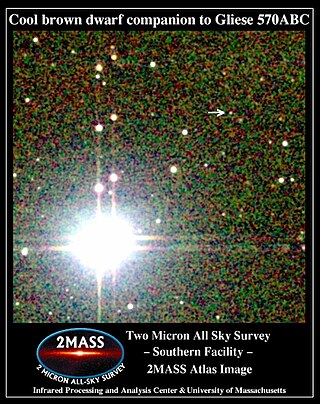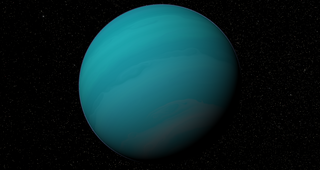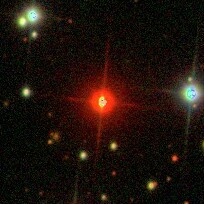Related Research Articles
Gliese 1061 is a red dwarf star located approximately 12 light-years from Earth in the southern constellation of Horologium. Even though it is a relatively nearby star, it has an apparent visual magnitude of about 13, so it can only be seen with at least a moderately-sized telescope.

Gliese 570 is a quaternary star system approximately 19 light-years away. The primary star is an orange dwarf star. The other secondary stars are themselves a binary system, two red dwarfs that orbit the primary star. A brown dwarf has been confirmed to be orbiting in the system. In 1998, an extrasolar planet was thought to orbit the primary star, but it was discounted in 2000.

Gliese 876 is a red dwarf approximately 15 light-years away from Earth in the constellation of Aquarius. It is one of the closest known stars to the Sun confirmed to possess a planetary system with more than two planets, after Gliese 1061, YZ Ceti, Tau Ceti, and Luyten's Star; as of 2018, four extrasolar planets have been found to orbit the star. The planetary system is also notable for the orbital properties of its planets. It is the only known system of orbital companions to exhibit a near-triple conjunction in the rare phenomenon of Laplace resonance. It is also the first extrasolar system around a normal star with measured coplanarity. While planets b and c are located in the system's habitable zone, they are giant planets believed to be analogous to Jupiter.

Gliese 436 is a red dwarf approximately 31.8 light-years away in the zodiac constellation of Leo. It has an apparent visual magnitude of 10.67, which is much too faint to be seen with the naked eye. However, it can be viewed with even a modest telescope of 2.4 in (6 cm) aperture. In 2004, the existence of an extrasolar planet, Gliese 436b, was verified as orbiting the star. This planet was later discovered to transit its host star.

Gliese 229 is a binary system composed of a red dwarf and the first brown dwarf seen by astronomers, 18.8 light years away in the constellation Lepus. The primary component has 58% of the mass of the Sun, 69% of the Sun's radius, and a very low projected rotation velocity of 1 km/s at the stellar equator.
Gliese 777, often abbreviated as Gl 777 or GJ 777, is a yellow subgiant approximately 52 light-years away in the constellation of Cygnus. The system is also a binary star system made up of two stars and possibly a third. As of 2005, two extrasolar planets are known to orbit the primary star.
Gliese 581 is a red dwarf star of spectral type M3V at the center of the Gliese 581 planetary system, about 20.5 light years away from Earth in the Libra constellation. Its estimated mass is about a third of that of the Sun, and it is the 101st closest known star system to the Sun. Gliese 581 is one of the oldest, least active M dwarfs known. Its low stellar activity improves the likelihood of its planets retaining significant atmospheres, and lessens the sterilizing impact of stellar flares.

Gliese 667 is a triple-star system in the constellation Scorpius lying at a distance of about 7.2 parsecs from Earth. All three of the stars have masses smaller than the Sun. There is a 12th-magnitude star close to the other three, but it is not gravitationally bound to the system. To the naked eye, the system appears to be a single faint star of magnitude 5.89.

Gliese 687, or GJ 687 (Gliese–Jahreiß 687) is a red dwarf in the constellation Draco. This is one of the closest stars to the Sun and lies at an approximate distance of less than 15 light years. Even though it is close by, it has a magnitude of about 9, so it can only be seen through a moderately sized telescope. Gliese 687 has a high proper motion, advancing 1.304 arcseconds per year across the sky. It has a net relative velocity of about 39 km/s. It is known to have a Neptune-mass planet. Old books and articles refer to it as Argelander Oeltzen 17415.

Gliese 876 b is an exoplanet orbiting the red dwarf Gliese 876. It completes one orbit in approximately 61 days. Discovered in June 1998, Gliese 876 b was the first planet to be discovered orbiting a red dwarf.
Gliese 849, or GJ 849, is a small, solitary star in the equatorial constellation of Aquarius. It has a reddish hue and is invisible to the naked eye with an apparent visual magnitude of 10.41. The distance to this star is 28.7 light years based on parallax, but it is drifting closer to the Sun with a radial velocity of −15.3 km/s. It has a pair of confirmed gas giant companions.
Gliese 317 is a small red dwarf star with two exoplanetary companions in the southern constellation of Pyxis. It is located at a distance of 49.6 light-years from the Sun based on parallax measurements, and is drifting further away with a radial velocity of +87.8 km/s. This star is too faint to be viewed with the naked eye, having an apparent visual magnitude of 11.98 and an absolute magnitude of 11.06.
Gliese 86 is a K-type main-sequence star approximately 35 light-years away in the constellation of Eridanus. It has been confirmed that a white dwarf orbits the primary star. In 1998 the European Southern Observatory announced that an extrasolar planet was orbiting the star.

Gliese 22, also catalogued V547 Cassiopeiae or ADS 440, is a hierarchical star system approximately 33 light-years away in the constellation of Cassiopeia. The system consists of pair of red dwarf stars, Gliese 22A and Gliese 22C, orbited by a third red dwarf Gliese 22B in an outer orbit of about 223 years.
Gliese 649 is a red dwarf star in the constellation of Hercules, located roughly 34 light years from the Sun. The star has been found to host an extrasolar planet.
Gliese 179 b is an extrasolar planet which orbits the M-type main sequence star Gliese 179, located approximately 40 light years away in the constellation Orion. This planet has a minimum mass somewhat less than Jupiter and it orbits at 2.42 AU from the star with an eccentricity slightly less than Pluto. The planetary distance ranges from 1.90 to 2.92 AU. This planet was discovered by using the radial velocity method from spectrograph taken at Keck Observatory on November 13, 2009. In 2023, the inclination and true mass of Gliese 179 b were determined via astrometry.
Gliese 3634 b is a super-Earth exoplanet in the orbit of the nearby red dwarf Gliese 3634 at approximately 64.5 light-years in constellation Hydra. The planet is approximately eight times the mass of Earth, and orbits its star every two and a half days at a distance of 0.0287 AU. The planet was the first to be discovered by a group of astronomers searching for exoplanets in the orbit of very-low-mass stars after the team reorganized their strategy, choosing to search for targets that they could also confirm using the transit method. However, a transit event associated with Gliese 3634 b was not detected. The planet's discovery was published in Astronomy and Astrophysics on February 8, 2011.

Gliese 832 c was a candidate exoplanet located 16.2 light-years away in the constellation of Grus, orbiting the star Gliese 832, a red dwarf. The existence of the planet was refuted in 2022, when a study found that the radial velocity signal shows characteristics of a signal originating from stellar activity, and not from a planet.
Gliese 251, also known as HIP 33226 or HD 265866, is a star located about 18 light years away from the Solar System. Located in the constellation of Gemini, it is the nearest star in this constellation. It is located near the boundary with Auriga, 49 arcminutes away from the bright star Theta Geminorum; due to its apparent magnitude of +9.89 it cannot be observed with the naked eye. The closest star to Gliese 251 is QY Aurigae, which is located 3.5 light years away.

Wolf 1069 is a red dwarf star located 31.2 light-years away from the Solar System in the constellation of Cygnus. The star has 17% the mass and 18% the radius of the Sun, a temperature of 3,158 K, and a slow rotation period of 150–170 days. It hosts one known exoplanet.
References
- ↑ Johnson; Butler, R. Paul; Marcy, Geoffrey W.; Fischer, Debra A.; Vogt, Steven S.; Wright, Jason T.; Peek, Kathryn M. G. (2007). "A New Planet Around an M Dwarf: Revealing a Correlation Between Exoplanets and Stellar Mass". The Astrophysical Journal. 670 (1): 833–840. arXiv: 0707.2409 . Bibcode:2007ApJ...670..833J. doi:10.1086/521720. S2CID 9135084.